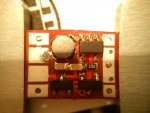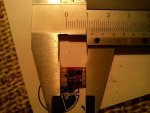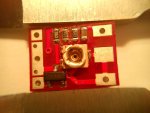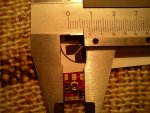foulmist
0
- Joined
- Mar 29, 2011
- Messages
- 1,056
- Points
- 48
It's size is relatively small (~9x12mm).
Side A


Side B


As some of you already know it's a constant voltage driver for Red/IR Laser diodes.
To set the current you must rely on the current/voltage characteristics of the diodes.
This is not that easy as the temperature is pretty much a factor which you don't want to have to deal with when setting your current.
This is why I prefer constant current to constant voltage output.
I don't have a spare laser diode to torture so I used my test load as a ..um.. a LOAD!
I made a video showing how the current varies at a constant voltage output with temperature.
At the beginning of the video I am showing a constant current buck driver set at 0.5A for reference. (the voltage is stable at 2.75V so I set the voltage of the Inferno to this)
Next I hook up the inferno and see what current will I get at 2.75V.
As you can see as the driver and load heat up the current rises.
If the temp decreases the current drops as well. While at constant current the current is stable over wide temperature range.
Now although it's been researched you can't be sure what current the diode will draw at a specific voltage. Efficiency varies with each diode and won't be a constant.
It's not a big difference after 10minutes of use 506mA vs 516mA on a heated load. But on a chilled load the current is almost 100mA less.
Maybe that's acceptable for Reds as for what this driver is intended.
Never the less efficiency is great - ~95% when outputing 2.75V@~0.5A and input is 3.6V/~0.4A
I like the driver a lot - it's small,efficient and adjustable(2.8V-3.12V on mine).
Mine could output slightly above 1A.
It has a low battery output for a LED (see the video),
Nice work!
BUT I wouldn't rely on it for any of my laser builds. Simply because I don't find the constant voltage a preferable choice.
I think that with constant current the diode will live a lot longer (at safe currents of course )
)
Thanks for the driver. HTV :beer: let me know when you need something. I will be glad to help!
Side A
Side B
As some of you already know it's a constant voltage driver for Red/IR Laser diodes.
To set the current you must rely on the current/voltage characteristics of the diodes.
This is not that easy as the temperature is pretty much a factor which you don't want to have to deal with when setting your current.
This is why I prefer constant current to constant voltage output.
I don't have a spare laser diode to torture so I used my test load as a ..um.. a LOAD!
I made a video showing how the current varies at a constant voltage output with temperature.
At the beginning of the video I am showing a constant current buck driver set at 0.5A for reference. (the voltage is stable at 2.75V so I set the voltage of the Inferno to this)
Next I hook up the inferno and see what current will I get at 2.75V.
As you can see as the driver and load heat up the current rises.
If the temp decreases the current drops as well. While at constant current the current is stable over wide temperature range.
Now although it's been researched you can't be sure what current the diode will draw at a specific voltage. Efficiency varies with each diode and won't be a constant.
It's not a big difference after 10minutes of use 506mA vs 516mA on a heated load. But on a chilled load the current is almost 100mA less.
Maybe that's acceptable for Reds as for what this driver is intended.
Never the less efficiency is great - ~95% when outputing 2.75V@~0.5A and input is 3.6V/~0.4A
I like the driver a lot - it's small,efficient and adjustable(2.8V-3.12V on mine).
Mine could output slightly above 1A.
It has a low battery output for a LED (see the video),
Nice work!
BUT I wouldn't rely on it for any of my laser builds. Simply because I don't find the constant voltage a preferable choice.
I think that with constant current the diode will live a lot longer (at safe currents of course
Thanks for the driver. HTV :beer: let me know when you need something. I will be glad to help!
Attachments
Last edited:









